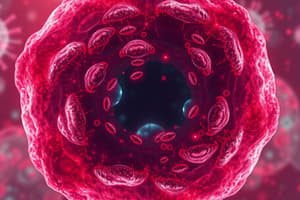Podcast
Questions and Answers
Which of the following is NOT a subtype of immunoglobulin deposition diseases?
Which of the following is NOT a subtype of immunoglobulin deposition diseases?
- Light chain deposition disease
- Multiple myeloma (correct)
- Primary amyloidosis
- Waldenstrom macroglobulinemia
Which of the following conditions is characterized by the presence of a monoclonal gammopathy but without any evidence of organ damage or other complications?
Which of the following conditions is characterized by the presence of a monoclonal gammopathy but without any evidence of organ damage or other complications?
- Immunoglobulin deposition diseases
- Multiple myeloma
- Monoclonal gammopathy of undetermined significance (MGUS) (correct)
- Plasma cytoma
What is the second most common presentation of patient é myeloma?
What is the second most common presentation of patient é myeloma?
- Bone pain
- Pneumonia
- Pyelonephritis
- Susceptibility to bacterial infections (correct)
Which of the following conditions is characterized by the presence of a single, localized plasma cell tumor?
Which of the following conditions is characterized by the presence of a single, localized plasma cell tumor?
Which of the following is NOT a common pathogen in the lungs of patients with é myeloma susceptible to bacterial infections?
Which of the following is NOT a common pathogen in the lungs of patients with é myeloma susceptible to bacterial infections?
Which of the following conditions is characterized by the accumulation of abnormal immunoglobulin fragments in various tissues, leading to organ damage?
Which of the following conditions is characterized by the accumulation of abnormal immunoglobulin fragments in various tissues, leading to organ damage?
Which of the following is a common bacterial infection that can occur in patients with é myeloma?
Which of the following is a common bacterial infection that can occur in patients with é myeloma?
Which of the following conditions is characterized by the presence of a monoclonal gammopathy and multiple bone lesions?
Which of the following conditions is characterized by the presence of a monoclonal gammopathy and multiple bone lesions?
Which of the following is a common pathogen in the urinary tract of patients with é myeloma susceptible to bacterial infections?
Which of the following is a common pathogen in the urinary tract of patients with é myeloma susceptible to bacterial infections?
What bacterial infection is most commonly associated with patient é myeloma?
What bacterial infection is most commonly associated with patient é myeloma?
What is the implication for a patient with a serum B2-microglobulin level of 4.0mg/L?
What is the implication for a patient with a serum B2-microglobulin level of 4.0mg/L?
Which of the following serum B2-microglobulin levels would indicate a poor prognosis?
Which of the following serum B2-microglobulin levels would indicate a poor prognosis?
What is the significance of a serum B2-microglobulin level of 3.5mg/L?
What is the significance of a serum B2-microglobulin level of 3.5mg/L?
A patient with a serum B2-microglobulin level of 5.0mg/L would be considered to have what kind of prognosis?
A patient with a serum B2-microglobulin level of 5.0mg/L would be considered to have what kind of prognosis?
Which of the following serum B2-microglobulin levels is associated with a good prognosis?
Which of the following serum B2-microglobulin levels is associated with a good prognosis?
What is a primary application of protein electrophoresis in the context of blood analysis?
What is a primary application of protein electrophoresis in the context of blood analysis?
Which of the following are specifically measured alongside protein electrophoresis to detect M spikes?
Which of the following are specifically measured alongside protein electrophoresis to detect M spikes?
What does the term "M spike" refer to in the context of blood analysis?
What does the term "M spike" refer to in the context of blood analysis?
What is the significance of detecting and characterizing M spikes in blood analysis?
What is the significance of detecting and characterizing M spikes in blood analysis?
Which of the following statements accurately describes the relationship between protein electrophoresis and M spikes?
Which of the following statements accurately describes the relationship between protein electrophoresis and M spikes?
In the context of blood chemistry, what is a primary characteristic associated with the disease described?
In the context of blood chemistry, what is a primary characteristic associated with the disease described?
Why is serum alkaline phosphatase typically normal despite extensive bone involvement in this condition?
Why is serum alkaline phosphatase typically normal despite extensive bone involvement in this condition?
Which of the following is NOT a blood chemistry finding typically observed in the disease described?
Which of the following is NOT a blood chemistry finding typically observed in the disease described?
Based on the information, what is the likely cause of the elevated serum calcium levels?
Based on the information, what is the likely cause of the elevated serum calcium levels?
Which of the following statements accurately represents the relationship between serum alkaline phosphatase and osteoblastic activity?
Which of the following statements accurately represents the relationship between serum alkaline phosphatase and osteoblastic activity?
What percentage of plasma cells in bone marrow is characteristic of the classic triad of myeloma?
What percentage of plasma cells in bone marrow is characteristic of the classic triad of myeloma?
Which of the following is NOT considered part of the classic triad of myeloma?
Which of the following is NOT considered part of the classic triad of myeloma?
What is the significance of the >10% threshold for plasma cells in bone marrow in the context of the classic triad of myeloma?
What is the significance of the >10% threshold for plasma cells in bone marrow in the context of the classic triad of myeloma?
Which of the following statements accurately describes the classic triad of myeloma?
Which of the following statements accurately describes the classic triad of myeloma?
Flashcards
MGUS
MGUS
Monoclonal gammopathy of undetermined significance, a benign condition.
Multiple Myeloma
Multiple Myeloma
A cancer of plasma cells leading to high levels of abnormal proteins.
Plasma Cytoma
Plasma Cytoma
Localized collection of neoplastic plasma cells in a defined area.
Primary Amyloidosis
Primary Amyloidosis
Signup and view all the flashcards
Immunoglobulin Deposition Diseases
Immunoglobulin Deposition Diseases
Signup and view all the flashcards
Bacterial infections in myeloma
Bacterial infections in myeloma
Signup and view all the flashcards
Common infections in myeloma
Common infections in myeloma
Signup and view all the flashcards
Pathogens causing pneumonia
Pathogens causing pneumonia
Signup and view all the flashcards
Pathogens in urinary infections
Pathogens in urinary infections
Signup and view all the flashcards
Gram-negative organisms
Gram-negative organisms
Signup and view all the flashcards
Raised serum calcium
Raised serum calcium
Signup and view all the flashcards
Urea nitrogen levels
Urea nitrogen levels
Signup and view all the flashcards
Creatinine levels
Creatinine levels
Signup and view all the flashcards
Uric acid levels
Uric acid levels
Signup and view all the flashcards
Serum alkaline phosphatase
Serum alkaline phosphatase
Signup and view all the flashcards
Serum B2-microglobulin Levels
Serum B2-microglobulin Levels
Signup and view all the flashcards
Good Prognosis Level
Good Prognosis Level
Signup and view all the flashcards
Bad Prognosis Level
Bad Prognosis Level
Signup and view all the flashcards
Prognosis Indicators
Prognosis Indicators
Signup and view all the flashcards
Microglobulin Significance
Microglobulin Significance
Signup and view all the flashcards
Protein Electrophoresis
Protein Electrophoresis
Signup and view all the flashcards
M spikes
M spikes
Signup and view all the flashcards
Serum Immunoglobulins
Serum Immunoglobulins
Signup and view all the flashcards
Free Light Chains
Free Light Chains
Signup and view all the flashcards
Detection of M spikes
Detection of M spikes
Signup and view all the flashcards
Marrow Plasmacytosis
Marrow Plasmacytosis
Signup and view all the flashcards
Classic Triad of Myeloma
Classic Triad of Myeloma
Signup and view all the flashcards
Lytic Bone Lesions
Lytic Bone Lesions
Signup and view all the flashcards
Elevated Serum Proteins
Elevated Serum Proteins
Signup and view all the flashcards
Symptoms of Myeloma
Symptoms of Myeloma
Signup and view all the flashcards
Study Notes
Blood L6: Plasma Cell Diseases
- Plasma cell maturation to antibody-secreting cells is triggered by antigens.
- Monoclonal neoplasms arise from B lymphocytes.
- Clinical manifestations involve neoplastic cell expansion, secretion of cell products (immunoglobulins/lymphokines), and host response.
- Classification includes:
- Monoclonal gammopathy of undetermined significance (MGUS)
- Multiple myeloma
- Plasma cytoma
- Immunoglobulin deposition diseases (primary amyloidosis, AL protein, systemic light/heavy chain diseases)
- Osteosclerotic myeloma (POEMS)
- Multiple myeloma features include polyneuropathy, organomegaly, endocrinopathy, and skin changes.
- Alkaline phosphatase (ALP) is high in metastatic carcinoma but normal in multiple myeloma (MM).
Multiple Myeloma
- Malignant proliferation of plasma cells from a single clone.
- Common in those aged 60+.
- Common symptoms include bone pain (affecting 70% of patients, often in back/ribs, worsened by movement), osteoporosis, pathological fractures, and lytic bone lesions.
- Renal failure affects ~25% of patients, with abnormal renal pathology seen in over half.
- Pathogenesis includes hypercalcemia, light-chain deposition, amyloidosis, urate nephropathy, drug toxicity (NSAID, bisphosphonates), and contrast dye-related renal dysfunction (light-chain cast nephropathy/amyloidosis).
- Anemia (normocytic and normochromic) affects ~80% of patients. Pathogenesis includes bone marrow infiltration, inhibitory factor production, hemolysis, and decreased erythropoietin levels.
- Hypercalcemia, renal affection, and anemia are key symptoms.
Other Factors and Investigations
- Recurrent infections are common, with Streptococcus pneumoniae, Staphylococcus aureus, Klebsiella pneumoniae, and Escherichia coli being frequent pathogens.
- Hyperviscosity, cryoglobulinemia, amyloid deposits, hypercalcemia, nerve compression, anti-neuronal antibodies, POEMS syndrome, and therapy-related toxicity may be associated.
- Hepatosplenomegaly and lymphadenopathy are uncommon.
- Hyperviscosity syndrome is found in ~2% of cases.
- Investigations such as complete blood count (CBC), erythrocyte sedimentation rate (ESR), blood chemistry (raised serum calcium, urea nitrogen, creatinine, uric acid; usually normal alkaline phosphatase despite bone involvement), and serum B2-microglobulin quantification are crucial. A B2-microglobulin level below 3.5 mg/L indicates a good prognosis, while above 5.5 mg/L suggests a poor prognosis.
- Protein electrophoresis, 24-hour urine protein excretion, and bone marrow analysis are vital diagnostic tools to measure free light chains and characterize the M component. (e.g., Bence Jones protein in urine).
- A significant finding is monoclonal plasma cells (CD138+) in bone marrow.
- Radiological investigations (chest/bone X-rays) may reveal lytic lesions/diffuse osteopenia, light chains >10mg/day in urine (Bence Jones protein).
Treatment
- Supportive Treatment:
- Hypercalcemia management: Bisphosphonates, glucocorticoids, hydration, natriuresis.
- Renal disorders: High fluid intake to prevent dehydration and help excrete light chains/calcium.
- Plasmapheresis (treating hyperviscosity).
- Pain control.
- Anemia treatment.
- Specific Treatment:
- Allogenic stem cell transplantation (patients under 50 with no comorbidities).
- Autologous stem cell transplantation (after aggressive chemotherapy to reduce tumor numbers).
- Chemotherapy.
Studying That Suits You
Use AI to generate personalized quizzes and flashcards to suit your learning preferences.




